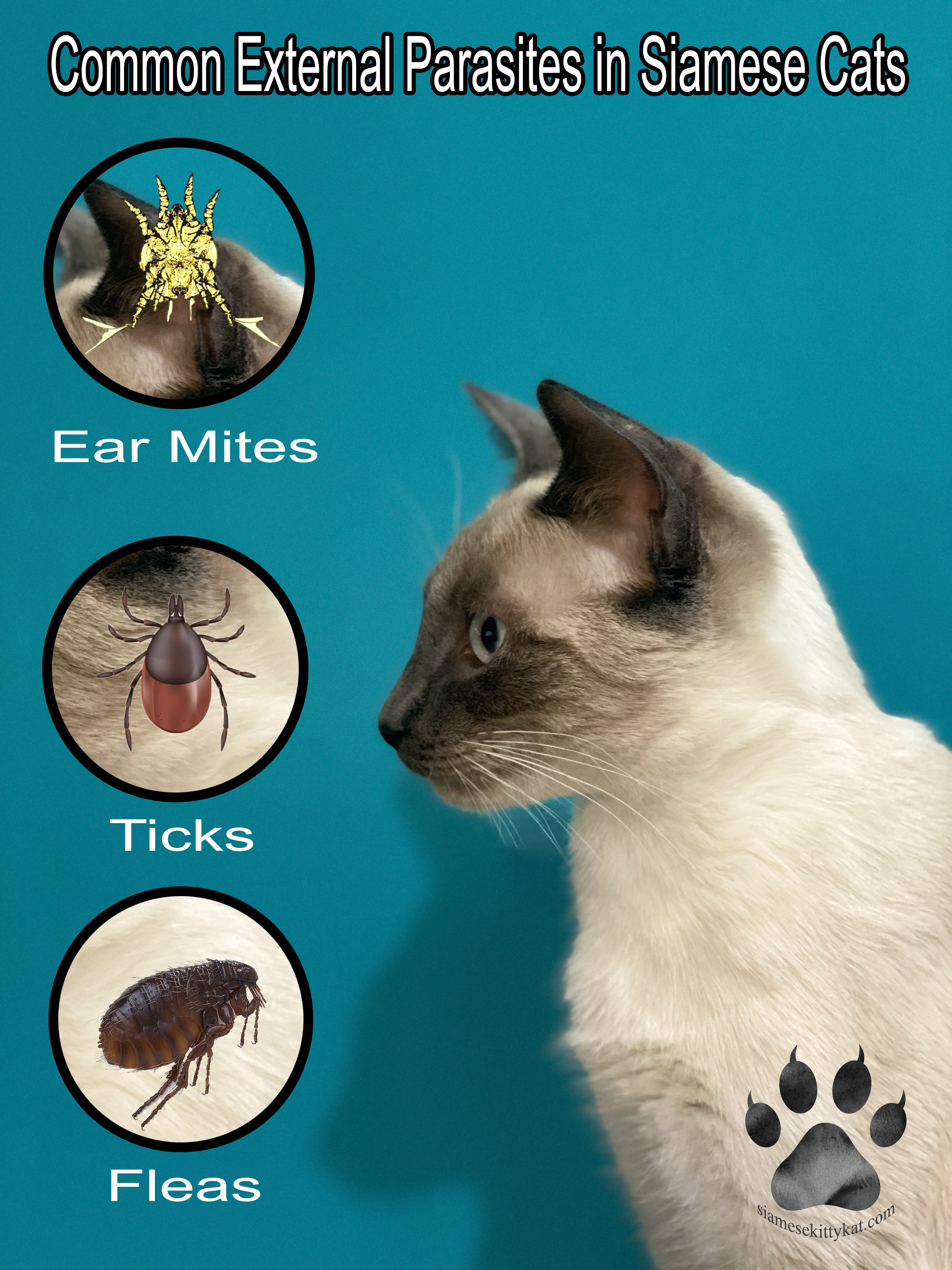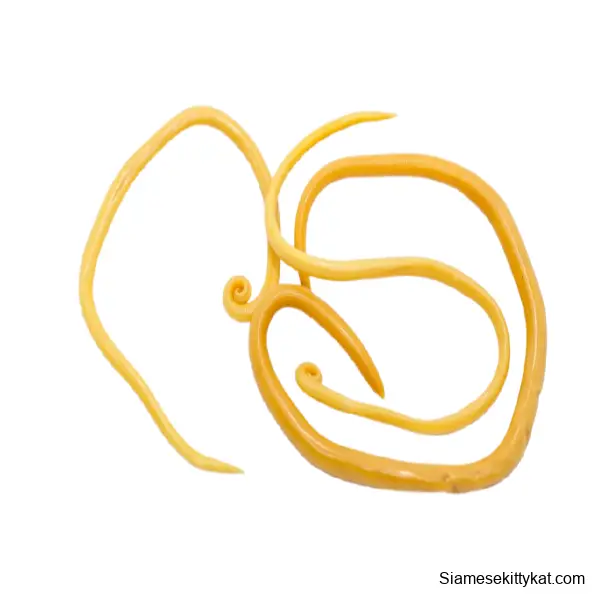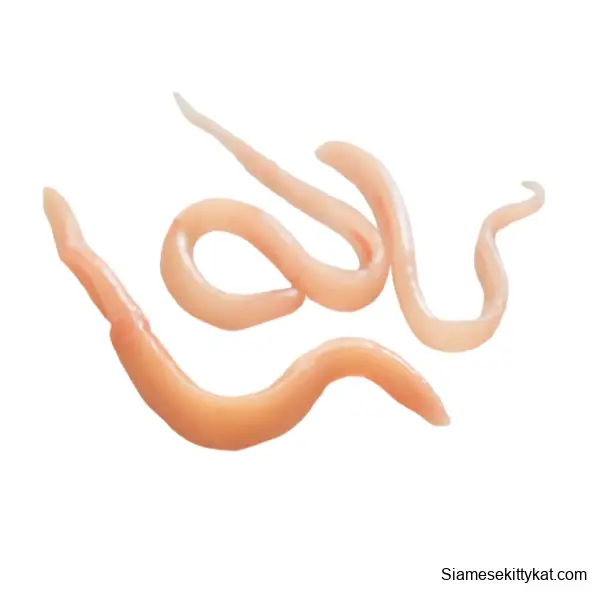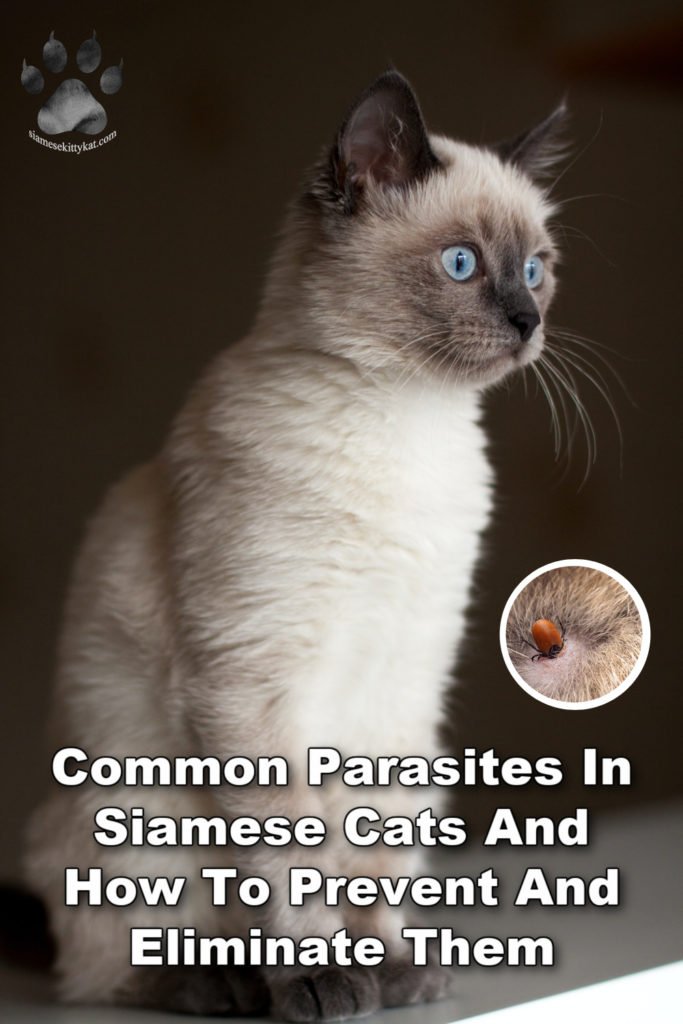Whether or not your Siamese is an indoor cat or an outdoor cat, both are susceptible to parasites.
You may be familiar with ticks and fleas – the most common external parasites. However, your Siamese is also vulnerable to much more dangerous internal parasites that affect the gastrointestinal tract.
Now you may be asking yourself, do I really need to know about parasites? Yes! Parasite prevention is incredibly important if you want your Siamese to stay healthy and thriving.
In this article, we’ll introduce you to all the common parasites your Siamese is susceptible to, as well as the ways you can prevent and eliminate them.
What are parasites?
When it comes to feline parasites, there are quite a few that can infect your Siamese – both external and internal.
Fleas and ticks are an example of external parasites. These parasites stick to the feline’s skin and fur and if treated, are the parasites that cause the least amount of concern.
Internal parasites infect the feline’s lungs, liver, heart, intestines, and stomach. These parasitic infections can cause much more fatal outcomes such as heartworms and infections in the gastrointestinal tract.
A parasite is an organism that attaches itself to a host – in this case, cats. These parasites can live inside or outside the body, causing many different types of diseases which in turn can be life-threatening. Aside from the ones caused by parasites, Siamese cats are prone to dental diseases too. Learn more about them by clicking on the link.
Your Siamese can pick up these parasites by:
More often than not, you’ll notice if your Siamese has external parasites since you can actually see them crawling around in their fur. However, some cats may show no signs at all, and it can be especially hard to tell if your Siamese has an internal infection.
What are the signs of a parasite infection?
Like many types of infections and diseases in Siamese cats, the symptoms depend on the severity of the infection. In the case of your kitty, they could experience numerous symptoms or none at all.
Parasites such as fleas and ticks can be big enough to be spotted, especially since your Siamese will be scratching and itching much more than usual.
Other parasitic infections can be identified through one or more of these symptoms:
What are external parasites?

External parasites attach themselves to the cat’s fur, skin, or ears. They come in a few different forms including:
Fleas
Fleas are the most common type of parasite around, attaching themselves to a whole range of animals such as birds, dogs, cats, and many other mammals.
Fleas feed on cats with their siphon-like mouths, piercing and sucking the blood of their hosts. If you find a flea on your Siamese, chances are it is an adult, since, for 3 out of 4 stages of their life, they live away from their hosts.
Legend has it that fleas will hop off their host, into the environment, and onto a new host, aka your Siamese. However, this is actually incorrect. A flea can only survive for a few days away from a host, so it’d much rather stick to the one it’s already found.
If your house is a suitable environment (warm and humid) it can become a breeding ground for fleas all year round.
If the infestation is caught early and treated accordingly, fleas often result in only irritation and scratching. However, some felines may have a much more serious allergic reaction to fleas, causing dermatitis.
If fleas are left untreated, they can also lead to tapeworms. Since fleas feed on the blood of their hosts, continued blood loss can lead to anemia, which is a huge risk for kittens.
The Signs
Since fleas are incredibly irritating for your Siamese, you’ll most likely notice them excessively itching and scratching. Other signs include:
The irritated areas on your Siamese will include the neck, back, abdomen, and the base of the tail.
Prevention
There are many ways you can protect your Siamese from these pests. A few of them include:
Vets usually recommend spot-on treatments as they are more effective than other options. If you’re unsure which product or brand you should purchase, consult your vet to ensure you’re using a safe one.
Treatment
If you suspect your cat has fleas, it’s best to consult a vet so they can recommend a treatment. Treating your Siamese for fleas is usually rather straightforward – it’s treating your house that is harder.
Fleas lay eggs that fall off your Siamese. These eggs will hatch inside your home and attach themselves to your Siamese once they become adults.
The fleas you see on your Siamese are only 5% of the problem since the other 95% come in the form of eggs and larvae. Therefore, eliminating the fleas on your Siamese is only half of the problem.
To get rid of the fleas from your home, you should:
Ticks
Ticks are similar to fleas in the sense they feed off the blood of their hosts. However, unlike fleas, ticks are considered arachnids instead of insects.
Ticks can be red, brown, tan or black, and swell up to the size of a pea once fully fed. Not only can ticks cause irritation and anemia, but they can also pass on diseases to your Siamese.
Cats mainly catch ticks when they come into another infected animal. If your Siamese is an indoor cat, chances are they’ll catch ticks from you. If you like to go on walks in woodlands or fields, ticks can attach themselves to your clothes. Once in your home, they’ll hop off your clothes and right onto your Siamese.
The Signs
Since ticks become quite large, you’ll usually be able to spot them sitting in your cat’s fur. Ticks have similar signs to fleas such as redness, itching, and scratching.
Ticks also carry many diseases, a common one known as ‘Q fever.’ If your Siamese contracts this disease, they may show the following signs:
Ticks will usually attach themselves to the head and neck of the cat. To check for ticks, part the fur and run your finger along their skin.
Prevention
The best way to keep ticks away from your cat is to keep them indoors. Ensure you check your clothes if you’ve been walking through grassy areas so you don’t bring any fleas home.
Other ways to prevent ticks attaching themselves to your Siamese include:
Treatment

As tempting as it may be, never pull a tick from your cat’s skin. Doing so can leave the mouth of the tick still attached, which will cause inflammation and possible infection.
Consult your vet if you see a tick, and they will provide you with a special tool designed to remove them. This will ensure nothing gets left behind. If you’re worried that your Siamese may have contracted a disease due to a tick bite, visit the vet as soon as possible.
A few flea products on the market will also kill ticks, while other products will just protect against them. Always consult your vet before using any type of treatment on your Siamese.
Ear Mites
Ear mites are tiny parasites, also referred to as Otodectes cynotis, common in both cats and dogs. These parasites look like white dots, however, it’s very difficult to see them with the naked eye.
Ear mites will get inside your cat’s ear canal and feed off the skin oils and ear wax. These parasites usually only live for around 2 months, but they can multiply quickly – taking just for days for their eggs to hatch.
Siamese cats of all ages can be affected, although outdoor cats are especially susceptible. Ear mites are transferred from host to host, so if your feline comes into contact with another cat who has ear mites, chances are they’ll get them too.
The Signs
If your Siamese is suffering from ear mites, you’ll notice them scratching at their ears and shaking their head in an attempt to relieve the itchiness.
The most common symptoms include:
Prevention
There are quite a few flea treatments out there that also cover ear mites. Ask your vet to recommend you an appropriate antiparasitic treatment.
Keeping your Siamese indoors will significantly lower the risk of ear mites. Aside from avoiding ear mites, keeping your cats indoors have other benefits too. Read more information about it by clicking on the link.
Treatment
Depending on the severity of the ear mites, your vet will recommend an appropriate treatment.
Available treatments include:
The PetArmor Ear Mite Treatment for Cats is one I specifically recommend. It can be used by cats of all ages and can help remove ticks too. Just click the link to get it from Amazon.
Some of these treatments will also work to kill the mites’ eggs, so need to be carried out even after you think the mites have gone. If you have more than one pet in the home, they may also need treating.
Just like fleas, ear mites stick around in your home. Therefore you should also treat your environment to get rid of them and prevent re-infecting your Siamese.
What are internal parasites?
Internal parasites, usually in the form of worms, can be especially life-threatening to kittens. Roundworms can lead to a stunt in growth development and hookworms can cause anemia.
Heartworms can be a threat to cats – transmitted by mosquitoes – that cause damage to the lungs and heart.
Internal parasites include:
Roundworms
If a Siamese kitten becomes infected with roundworms, this parasite can stunt their growth. When their growth is affected, so is their digestive system, resulting in excessive gas formation. Kittens with roundworms will often look pot-bellied.
Roundworms don’t require a host to spread from cat to cat, unlike external parasites. These worms can spread through ingestion of other infected feline feces.
Hookworms
Hookworm is one of the most common intestinal parasites found in cats. The hookworm measures about 2cms long and attaches itself to the small intestine lining. There, it will feed on the blood of it’s host.
Cats can become infected with hookworms when they come in contact with contaminated soil.
Hookworms can cause severe anemia in felines due to their blood-sucking nature. Eczema can also occur as a side effect of hookworm since they can either enter the feline through the mouth or bury their way through the skin.
Tapeworms
Tapeworms are unlike other internal parasites in the sense they have to have an intermediate host (such as a bird or a flea) to infect a Siamese. This means an infected cat can’t pass tapeworm onto another cat.
A form of tapeworm, known as Dipylidium caninum, is rather common in cats. This can cause a whole range of problems such as stunting the growth of kittens and affecting digestive systems. A Siamese cat can become infected with this form of tapeworm if they ingest an infected flea.
Taenia is another form of tapeworm that infects adult cats. Taenia doesn’t cause many problems for adult cats if treated in time. This species of tapeworm can be passed from rodents such as rabbits and birds.
Heartworms
Unlike dogs, heartworm is quite uncommon in cats. However, it can happen, especially in certain areas of North America.
A Siamese cat becomes infected by heartworms if they have been bitten by a mosquito. When the mosquito feeds on a cat, it may inject the heartworm larvae into the bloodstream. These larvae will then make their way to the heart.
The symptoms of heartworms can vary, and they may lead to coughing, weight loss, rapid breathing, and vomiting. It is possible for a cat that is infected with heartworms to die suddenly.
Heartworms are much larger than other internal parasites, reaching sizes of 36cm long. They locate themselves in the right ventricle of the heart.
| Roundworms | can spread through ingestion of other feline feces |  |
| Hookworms | comes from contaminated soil and enters the feline’s body through their mouth or skin. |  |
| Tapeworms | passed on from another infected host like a bird or a flea |  |
| Heartworms | injected into the cat’s bloodstream by a mosquito bite. |  |
What are the symptoms of worms in cats?
If your Siamese is infected with worms, you may notice the following symptoms:
How can I prevent worms in my cat?
To prevent your Siamese from contracting worms, you must give them worming treatment. Kittens especially should be wormed every two weeks, up to the age of 12 weeks old. They can then be treated every 3 months.
Pregnant felines should also be treated during mating and before giving birth to avoid passing worms to their kittens. Ask your vet to recommend which worming treatment you should give to your Siamese.
Ways in which you can prevent worms include:
How can worms be treated?
Always consult your vet if you’re concerned your Siamese could be infected with worms. There may be a few home remedies out there, but nothing will be better than medicine prescribed by your vet!
There are quite a few parasites out there, both internal and external, waiting to pray on your vulnerable Siamese. The best thing you can do for your kitty is ensuring they have their regular treatments of medication, such as flea treatments and deworming treatments.
Always consult your vet if you’re concerned your Siamese may be infected with parasites!
We gathered all the health tips tailored towards maintaining your Siamese cat’s optimal well-being. Check it out here: Siamese Cat Health: A Complete Guide
Get your FREE Siamese Cat 2026 Printable Calendar

